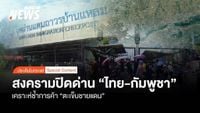The longstanding border dispute between Thailand and Cambodia remains a complex and sensitive issue, with recent developments underscoring the challenges both nations face in resolving territorial claims and managing bilateral relations. Despite ongoing negotiations and efforts to employ modern technology for boundary demarcation, tensions persist, influencing trade, security, and the daily lives of people living near the border.
On June 15, 2025, the Joint Boundary Commission (JBC) meeting between Thailand and Cambodia concluded in Phnom Penh after two days of discussions. However, the talks ended with differing accounts regarding key issues, particularly the use of the 1:200,000 scale map derived from the 1904 and 1907 Siam-France boundary treaties. Cambodia asserted that Thailand had accepted this map as a basis for border demarcation, a claim that Thailand promptly denied.
Following the meeting, the Thai Ministry of Foreign Affairs issued a statement on June 16 clarifying that no agreement had been reached on the 1:200,000 map. Instead, both parties agreed to utilize LiDAR technology—laser-based aerial surveying—to create new aerial photographs for boundary surveying and demarcation. This approach aims to produce a jointly agreed-upon "photo map" independent of the disputed 1:200,000 and 1:50,000 scale maps previously referenced by both sides.
Mr. Prasat Prasatwinitchai, chairman of the JBC from the Thai side, emphasized that the new map would be developed through established JBC procedures dating back to 2003. The process involves verifying boundary markers installed between 1919 and 1920, of which 74 exist, with 45 already mutually accepted and 29 still under discussion. The new aerial photographs will support clearer demarcation, with both sides agreeing on the survey routes along watershed lines before installing additional markers. Mr. Prasat stated, "The photo map is unrelated to the 1:200,000 or 1:50,000 maps previously mentioned. It is a new aerial map, possibly at a 1:50,000 scale, but created jointly by both parties." The JBC plans a special meeting hosted by Thailand in September 2025 to advance these efforts.
The 1:200,000 scale map, particularly the "Dongrak" sheet, has been a focal point in the dispute for decades. Cambodia first referenced this map in a 1959 complaint to the International Court of Justice (ICJ), claiming Thai occupation of territory housing the Preah Vihear temple. Thailand contested the map's validity, arguing it was never officially recognized by the Siam-France joint commission and that geographical watershed boundaries placed the temple within Thai territory.
Nevertheless, the ICJ ruled in 1962 that the Preah Vihear temple belonged to Cambodia, citing Thailand's long-standing tacit acceptance of the map by not objecting and even producing maps indicating the temple's location within Cambodia. Cambodia renewed its request for interpretation of the 1962 judgment in 2011 after border clashes, leading to a 2013 ruling that Thailand must withdraw troops from the "Phra Wihan mountain top" area. The Thai Foreign Ministry clarified then that the ICJ did not rule that the 1:200,000 map was binding for the entire border demarcation.
Further complicating matters, Cambodia's recent statements to the ICJ have highlighted Thailand's submission of a 1:50,000 scale map labeled L7017 in 2007, which Cambodia claims contradicts prior agreements between technical experts from both countries under the 2000 Memorandum of Understanding (MoU). The MoU established the JBC and set out that boundary demarcation should adhere to the 1904 and 1907 treaties and related maps. Thailand responded by clarifying the L7017 map was not secret, had been widely distributed, and that Cambodia had been aware of its boundary lines since 1962.
Alongside these diplomatic and legal efforts, the Thai government has taken proactive steps to manage the border situation on the ground. On June 17, 2025, the Thai-Cambodian Border Situation Management Center (TCBSC) was established to coordinate short-term and long-term responses to border issues. Chaired by Deputy Defense Minister General Natthaphon Nakpanich, the center includes senior officials from the National Security Council, Ministry of Foreign Affairs, Ministry of Interior, and other key agencies.
The TCBSC operates as a roundtable forum for discussion, recommendations, and support rather than a command center, emphasizing collaboration among agencies. Daily meetings are scheduled at 9:30 a.m. except Tuesdays, when meetings occur at 1:30 p.m. to accommodate Cabinet sessions. The center aims to swiftly resolve problems affecting local residents while sustaining international cooperation efforts. It also focuses on clear communication to reduce misunderstandings between Thailand and Cambodia, especially regarding conflicting information that has previously caused confusion.
Despite these efforts, border tensions have led to disruptions in cross-border trade and movement. The Burapha Task Force in Khlong Luek, Aranyaprathet District, Sa Kaeo Province, closed both permanent and temporary border checkpoints, affecting 18 points across seven provinces. This action followed Cambodian Senate President Hun Sen's announcement of a 24-hour border closure to pressure Thailand into reopening crossings, coinciding with preparations to repatriate over 500,000 Cambodian workers.
While the five permanent checkpoints under Thailand's Customs Department remain open, temporary checkpoints have closed for goods, though pedestrian crossings continue during designated hours. This closure has particularly impacted small traders who rely on daily cross-border commerce. However, the Thai Chamber of Commerce and the Board of Trade of Thailand, led by Chairman Poj Aramwattananont, expressed support for upholding sovereignty and stability. They noted that overall trade and investment remain robust due to multiple export channels and Cambodian consumers' preference for Thai products. Mr. Poj also highlighted the availability of alternative labor sources to replace Cambodian workers if necessary.
Officials from the Department of Foreign Trade and the Department of Internal Trade have been closely monitoring the situation. Arada Fuangtong, Director-General of the Department of Foreign Trade, confirmed ongoing discussions with private sector representatives and readiness to adapt transport management if border disruptions persist. Wittayakorn Maneenetr, Director-General of the Department of Internal Trade, reported that fruit trade in eastern provinces like Chanthaburi remains stable, with durian and mangosteen exports to China continuing as harvest season ends. Two main checkpoints in Chanthaburi serve as distribution points, though limited volumes cross due to closures.
Trade data from 2024 indicates Thailand's exports to Cambodia totaled approximately 300 billion baht, with border trade accounting for 140 billion baht. Key border provinces—Trat, Chanthaburi, Sa Kaeo, Buriram, Surin, Sisaket, and Ubon Ratchathani—have 18 checkpoints, including eight permanent, nine commercial, and one tourist checkpoint. Of these, 16 remain operational, with two closed: Muen Dan commercial checkpoint in Trat and the Preah Vihear mountain tourist checkpoint in Sisaket. Closure of the three major customs points—Aranyaprathet, Khlong Yai, and Chanthaburi—would affect over 95% of border trade.
Thailand's top exports to Cambodia include various beverages, internal combustion engines, motorcycle parts, and agricultural industrial products, while imports from Cambodia consist mainly of vegetables, aluminum scrap, wire and cable, and vehicle parts. Tourism also plays a role in bilateral relations; Thais represent the largest group of foreign visitors to Cambodia, accounting for 32% of all foreign tourists, with 500,000 Thais visiting in the first quarter of 2025—a 20% increase. Conversely, Cambodian tourists to Thailand comprise only 1% of foreign visitors, with a 14% decrease in the first five months of 2025.
Overall, Thailand's tourism sector faces challenges, with the Kasikorn Research Center projecting a 2.8% decline in foreign tourists for 2025, marking the first drop in three years. Factors include safety concerns, regional instability, natural disasters, and geopolitical conflicts affecting visitor confidence and spending patterns.
As Thailand and Cambodia navigate these intertwined issues of border demarcation, security coordination, trade disruptions, and tourism fluctuations, the emphasis remains on diplomatic dialogue, technological cooperation, and protecting the welfare of border communities. The upcoming special JBC meeting in September and the continued work of the Thai-Cambodian Border Situation Management Center will be critical in shaping the path toward peaceful resolution and mutual benefit.


